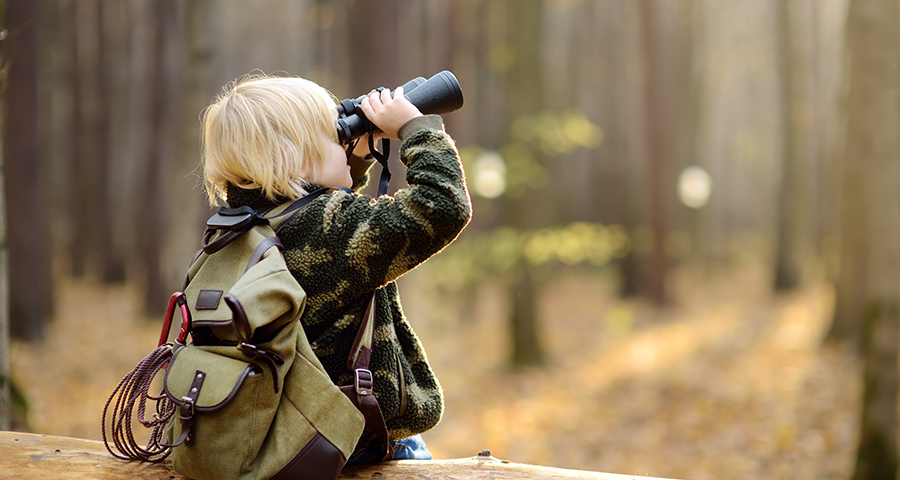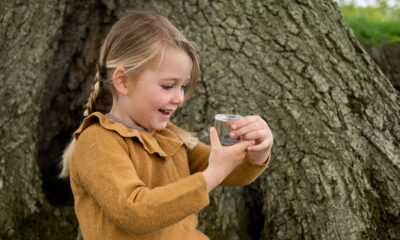Activities
Birdwatching With Kids | Spot Birds While Hiking With Your Family


Activities & Days Out / 20 January, 2025 / Christina Walter
Have you ever thought about birdwatching with the kids? Whether part of a resolution or not, the turn of the new year is a perfect time to get out and about among nature with your family. So, layer up, strap on your hiking boots, plot a route, and explore some of the various picturesque hiking trails around the UK.
Hiking is a great way to work in some much-needed physical exercise, and it can be enjoyed by just about anyone no matter their age or level of fitness. It’s also a perfect opportunity to spend some quality time with family members. Still, one of the best things about going for a hike is the diverse flora and fauna you can often spot.
Birdwatching with kids
Next time you’re strolling along bridle paths, crossing muddy fields or rambling through woodlands, kids in tow, why not give birdwatching a go? Birdwatching with kids is a fantastic thing to do. There are hundreds of fascinating bird species to spot around the UK, and it’s the perfect activity to combine with a family winter hike.
To help you get the most out of your birdwatching experience while out hiking, the RSPB Shop offers a range of ‘twitching essentials,’ as well as some expert tips and guidance for birdwatching with the kids.
What to spot and where
Whether you’re surrounded by greenery, or you live in a bustling inner city, you’re rarely too far from a good hiking trail. The RSPB has more than 170 nature reserves across the UK — from the lochs of Scotland to the rugged coastline of Northern Ireland — and an RSPB membership entitles you to free entry to all of them all year round. RSPB’s reserves play host to a wide variety of events and activities geared towards younger children, too, making them perfect for a family day out.
The UK is home to over 600 bird species, from those that frequent our gardens to large aquatic species and birds of prey. Many migratory birds stop off on our shores along their journeys. Whether you’ve got a hiking trail on your doorstep or you need to venture a little further afield to find adventure, you’re sure to come across many intriguing bird species if you know how to find them.
Some of the best places to spot birds while hiking in the UK:
- Encompassing Devon, Cornwall, and Dorset, the rolling hills and rocky coastlines of the South West of England are home to an array of seabirds, waterfowl, and birds of prey. At Exminster and Powderham Marshes, for example — just five miles from Exeter city centre — resident flocks of ducks, geese and waders are plentiful, while regular visitors include lapwings, redshanks, warblers and wigeons.
- Home to England’s highest mountain and its longest lake, the Lake District boasts a landscape rich with U-shaped valleys and craggy hills. Haweswater’s rugged vista offers a variety of hiking trails, and it’s a great spot for observing birds of prey such as peregrines and kestrels, as well as redstarts, guillemots and flycatchers.
- From its dramatic glens to its imposing lochs, Scotland is a hiker’s paradise and home to a diverse bird population. On the shore of Loch Sunart on Scotland’s west coast, Glenborrodale is the perfect place to spot coastal birds such as oystercatchers and sandpipers, and one of the only places in the UK where you might be lucky enough to see a golden eagle swooping by.
- From the ancient woodlands of the Brecon Beacons to the jagged cliffs of the Pembrokeshire coast, Wales boasts countless hiking trails and a fascinating array of bird species. Nestled in the spectacular Mawddach Valley, Coed Garth Gell is a woodland and heathland nature reserve where you might spot a cuckoo, a grasshopper warbler, or the lesser redpoll to name a few.
What to take with you
Of course, the key to a safe and successful hiking trip is preparation: whether you’re simply heading out for an afternoon among nature or you’re about to embark on a family walking holiday, draw up a ‘kit list’ and make sure you plan for every eventuality.
Comfortable, durable footwear is essential, and you should dress according to the seasons: layer up with warm outdoor gear in brisker temperatures, for example, and don’t forget to take waterproofs in case of rain. In the summer, protect your family with hats, sunscreen, and wraparound sunglasses.
A good pair of binoculars is a necessity for birdwatching, particularly for observing bird species that might be harder to spot with the naked eye. Things to consider when choosing your perfect pair include:
- Budget: a ‘starter’ level pair of binoculars will cost between £50 and £150, while a more advanced pair will set you back £350 or more. For younger children, an inexpensive pair of junior binoculars should do the trick.
- Performance: what level of magnification will you need, for starters? Eight or 10x magnification is typically recommended for birdwatching.
- Size: if you’re travelling, you might want to opt for a more compact pair, so they don’t take up too much room in your luggage.
- Care: don’t forget to keep an optics cleaning kit handy to keep your ‘bins’ in tip-top condition!
You’ll want to take a decent camera to keep a visual record of your ornithological encounters. Unless you’re a budding Wildlife Photographer of the Year, you won’t need to spend a fortune on a fancy model, but you’ll at least want one with an autofocus function and zooming capabilities. Failing that, most smartphones double up as pretty impressive cameras nowadays.
Some bird species are easily distinguished by their plumage, while others might be harder to identify: take along a field guide such as the RSPB’s bestselling Handbook of British Birds to help you classify each bird you spot based on its appearance and most notable characteristics. For younger bird spotters, The Little Book of Garden Bird Songs gets a hearty recommendation.
What to look out for
Whether your family are avid birdwatchers or you’re all trying the hobby out for the first time, the most rewarding thing about birdwatching is observing a vast array of diverse bird species in their natural habitats.
On your next hike, take a field notebook and pen or pencil with you and make it a family competition! Offer prizes to the person who logs the most diverse range of species and encourage everyone to record the following details about each bird they spot:
Behaviour: each bird species will exhibit unique behaviour, which can often help to distinguish between one species and another. Pay close attention to little details like the bird’s posture, its flight pattern, and whether it appears shy or bold.
Size and shape: from the tiny goldcrest to the imposing common crane, the size and shape of a bird — including its wingspan, beak size and leg length — is key in determining its species. Some can even be identified by their distinctive silhouettes.
Colour patterns: birds boast some of the most dazzling and unique colour patterns in the animal kingdom, so keep an eye out for telltale hues; the common kingfisher, for example, is characterised by its striking combination of blue, cyan and orange.
Sound: many birds are renowned for their singing ability, and country hikes are often soundtracked by a chorus of birdsong. Try to match the call to the species, and you may be able to identify which bird you’re listening to without even seeing it.
Habitat: the UK has a diverse range of landscapes, from boggy marshland to lush forests and sandy beaches. Many birds tend to stick to very specific habitats, so location is often a key determining factor between species.
Important things to remember while birdwatching with the kids
Hiking and birdwatching are activities that can be enjoyed by the whole family, but it’s important to do them safely and responsibly. With this in mind, here are a few things to consider before your family embarks on their next adventure:
Observe the birdwatchers’ code: almost 3 million people go birdwatching every year in the UK. The birdwatchers’ code ensures we keep birds and their habitats safe while respecting the people around us. Tips include:
- Not getting too close to birds or disturbing their habitats
- Staying as quiet as possible so as not to spook them
- Being a birdwatching ambassador (e.g., raising awareness of bird conservation, engaging with passers-by)
- Sending your bird sightings to projects such as BirdTrack
Respect your surroundings: it’s important to observe the rules of the countryside when you’re out and about. Be mindful of local residents and landowners, behave responsibly, and leave no trace — be sure to dispose of all litter appropriately. If your kids are accompanying you on your hike, turning this into a game of “see who can find and dispose of five pieces of litter the fastest” always works a treat.
Plan ahead: pack a first aid kit for emergencies, ensure you have a fully-charged mobile phone on you, and map out your route before you go. Make sure someone else knows where you’re going, too — just in case.
Keep yourself safe: stick to designated paths, beware of unstable terrains, and steer clear of anywhere that looks like it might be unsafe. It’s never sensible to go out hiking in the dark, so keep to daylight hours but pack a few head torches just in case.
Article by the RSBP
Read Next
Struggling With Screen Time? Here’s How To Find A Healthy Balance
Boost Your Child’s Social Skills: 10 Games To Play Together For Healthy Development
-

 Destination8 months ago
Destination8 months agoSingapore Airlines CEO set to join board of Air India, BA News, BA
-

 Breaking News10 months ago
Breaking News10 months agoCroatia to reintroduce compulsory military draft as regional tensions soar
-

 Tech News12 months ago
Tech News12 months agoBangladeshi police agents accused of selling citizens’ personal information on Telegram
-

 Gadgets3 months ago
Gadgets3 months agoSupernatural Season 16 Revival News, Cast, Plot and Release Date
-

 Productivity11 months ago
Productivity11 months agoHow Your Contact Center Can Become A Customer Engagement Center
-

 Gadgets3 weeks ago
Gadgets3 weeks agoFallout Season 2 Potential Release Date, Cast, Plot and News
-

 Breaking News10 months ago
Breaking News10 months agoBangladesh crisis: Refaat Ahmed sworn in as Bangladesh’s new chief justice
-

 Toys12 months ago
Toys12 months ago15 of the Best Trike & Tricycles Mums Recommend























